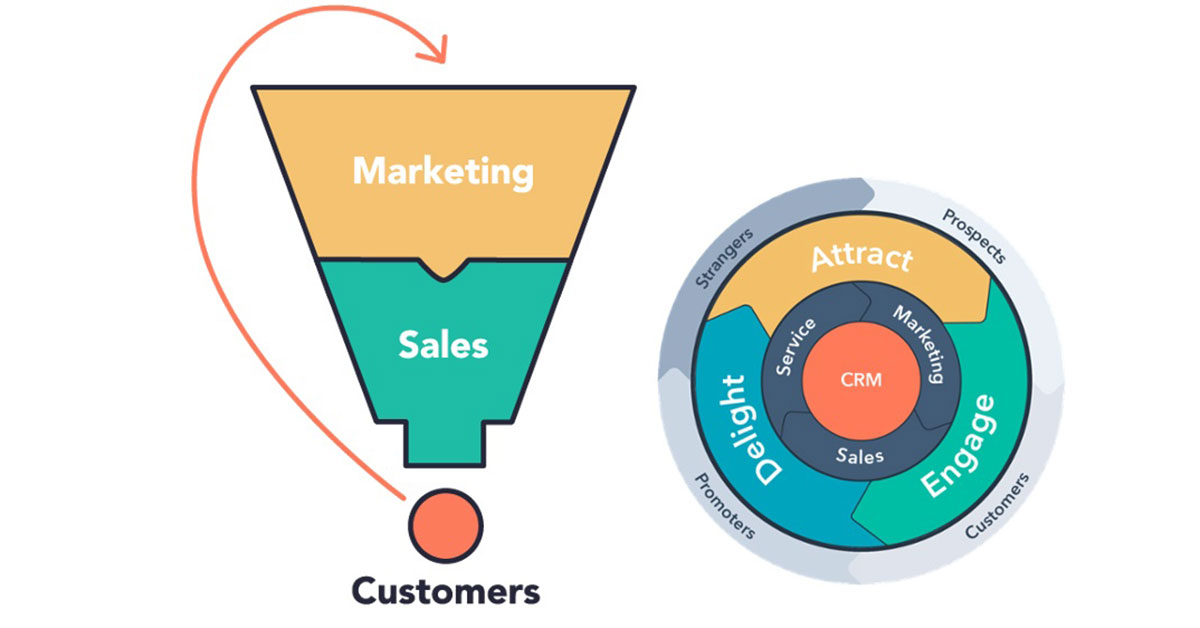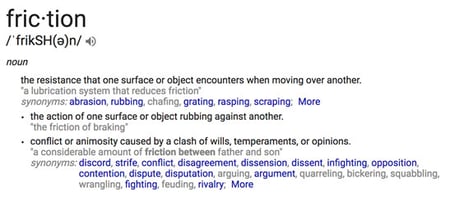Hubspot Tries to Reinvent “Inbound Marketing” as “Growth Marketing”
Is the Funnel Broken? Hubspot believes the Flywheel is Better.
The basic case that Hubspot is making by shifting themselves and their agencies to a flywheel rather than a funnel comes down to two primary points:
- Customers are an input to marketing and sales, not just an output
- Funnels are a linear process where the energy you put in is lost when you acquire or don’t acquire a customer. Flywheels store and release energy to continue to feed your company’s growth.
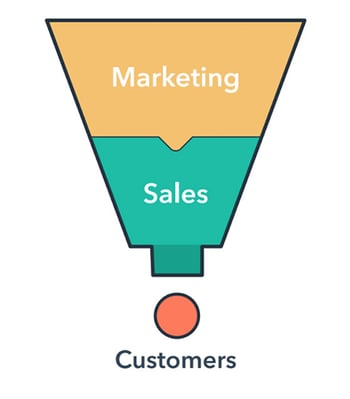
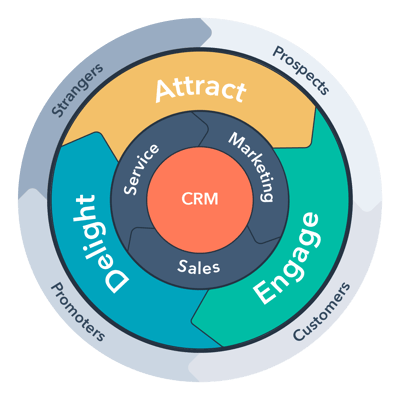
My favorite pieces of the flywheel concepts presented by different Hubspotters at Inbound 2018 were the concepts related to friction/force and related to the customer journey. To paraphrase:
- Your customer’s journey begins the first time they ever hear about your brand and it ends…. NEVER
- Flywheels are most effective when you can reduce friction while applying force to the right component of your company’s flywheel
Whether you are willing to adopt the new flywheel or stick to your funnel, you need to recognize that your customer’s experience with your company will impact their long-term revenue and your ability to market and sell to other customers in the future.
Your company also needs to be thinking about where you should apply forces to your marketing and sales efforts as well as where you can reduce friction. Do you need to apply force to customer acquisition, conversion or do you need to improve your service and net promoter score?
Where is the friction in your company’s marketing?
Having been in the online marketing field for about twenty years, I’ve seen all types of friction. The most common type of friction I see is between departments at an organization.
Sales and marketing teams are often the source of the friction. They are sometimes competitive and not cooperative.
- Sales desires prospects of a certain type and marketing is not generating enough of those types of leads.
- Marketing is often planning campaigns or promotions without aligning them with sales goals and targets.
How your sales and marketing teams are aligned is key to reducing friction. It’s absolutely imperative that you company has a good process to hand a lead from marketing qualified lead to sales qualified lead and then from closed-lost back to your nurturing efforts.
Product and service delivery can often be a giant source of friction. Ultimately if your customers are not delighted by what you are delivering, then your sales and marketing will fail or struggle.
Simply by improving marketing and generating more leads and sales, you will not be successful. You may temporarily increase revenues, but any gains here would be temporary. To help your overall marketing, start by improving customer satisfaction.
Leadership might be the primary source of friction in your company. In many small to mid-sized businesses that we work with, this can be the case.
It can take the shape of unreal expectations and an inability to try new things.
It usually goes like this:
- The C-level wants more leads and sales but doesn’t want to change strategies or platforms to adapt to 2018.
- They hire a growth marketer or agency but are wed to cold calling and trade shows.
- The result is attempting to implement inbound software and strategies to an outbound or broadcast mentality.
If leaders want a change in results, then they have to be willing to accept a change in strategies.
Empower your marketing team and hold them accountable. If you are a leader who might be causing some friction, think about ways you can empower your people and reduce the drag on their motivation.
Employee Relations and HR can be a major source of friction.
If your team is unhappy or you have high turnover, it’s unlikely that any sales and marketing effort will turn out a strong ROI. If your company has a bad work environment, it is going to pose serious challenges to your flywheel. It is likely to be the cause of product or service failures and leads to inefficiencies at every stage of decision making.
When you recognize problems in your staff, fix those before investing in lead generation or nurturing activities. Make sure your core strengths are functioning and then promote them.
What is “Growth Marketing” or “Growth Marketers”?
Honestly, before Inbound, I had never heard the phrase. I attended Rachel Leist’s session on growth marketing and loved the concept. Here are some core points from her presentation:
- First, growth marketers have a full funnel focus
- Next, they integrate the marketing and product teams as closely as possible
- Third, they focus on impact
- Fourth, they have an experimental mindset
- Finally, they are analytics (or data) crazy!
I believe that that 3-5 also describe good “inbound marketers”. But one and two are the key here.
Rachel used the phrase “SPARKETING” or the merger of Sales + Product + Marketing.
As inbounders, we are usually willing to give up the connection to products or sales if we have a contract or relationship with the marketing team. But this simply handcuffs your marketing efforts.
If you have true alignment in these three departments, everyone who is working on increasing sales and revenue will be more effective.
My key takeaway on growth marketers is that they are willing to apply force at any stage of the flywheel. They will use marketing concepts, data and messaging to do whatever is needed to secure revenue gains. I would describe it as a more holistic approach to marketing than most companies are used to.
How Does that Differ from “Inbound Marketing”?
It doesn’t. Inbound marketing remains an absolutely critical component of growth marketing.
When you market to your targeted personas, your company needs to engage them in an inbound way, not through INTERRUPTION or BROADCAST marketing.
In 2018, buyers want to interact with your brand on their terms.
- They fast forward through your TV ads or browse their second screen while they air.
- They gab during your radio ad or surf channels.
But when your buyers are ready, they will search the web, search their e-mail inbox or ask for a recommendation on Facebook.
Will your company be there when they ask for that information? That is inbound marketing.
Clients differentiate between organic, paid search, social media marketing, and e-mail marketing. These are all great channels for inbound. The key to all of them is the user has the choice, the user has the power. The user is coming “inbound” to your company. An effective inbound marketing campaign will leverage all of these channels and more.
This doesn’t mean that interruption and broadcast marketing doesn’t have a place in your marketing efforts. For many brands broadcast is absolutely critical to brand awareness and differentiation. But when you run effective branding campaigns, it will be your inbound marketing that needs to convert the buyer when they act on your broadcast. Your digital, your lead capture, your automation and your follow up will be the difference between successful and unsuccessful media buys.
Will Hubspot’s Brand Shift from Funnel to Flywheel work and gain adoption?
With more than 2000 partners worldwide, Hubspot has the megaphone to drive awareness of their flywheel. Add to this network of delighted promoters and their customer base and Hubspot will have many people doing the promotion of the flywheel concept for them.
This blog post is a perfect example of that!
In addition, Hubspot has their own successful blog and content marketing efforts that they can leverage to promote awareness and adoption of the flywheel.
Consider what Hubspot has done with the phrase “inbound marketing.” How often do you hear that phrase and not hear “Hubspot” somewhere in the same conversation? Hubspot has:
- Invented and branded this term
- successfully taught people how to do it right
- educated the marketplace on how effective it is as compared to outbound or direct marketing
- created an industry of agencies who are dedicated to its philosophy of inbound marketing
Based on the logic of the flywheel and Hubspot’s success with the phrase “inbound marketing”, I believe there will certainly be conversations of flywheel versus funnel in the next 1-2 years.
In boardrooms and coffee rooms, executives and marketing directors will be discussing this concept and considering their alignment with sales, service, marketing and product. As they consider these handoffs from department to department, they will be seeking ways to reduce friction and increase the success of their organizations. Whether they do this with a funnel graphic or flywheel graphic on the whiteboard, it will have an impact on the world of inbound marketing.
Overheard on #INBOUND18 shuttle: A very heated debate about lead funnels versus flywheels. pic.twitter.com/03WTQZNXpE
— Michael Bartholow #INBOUND18 (@michaelb3600) September 6, 2018
Thrilled to see this conceptual shift from #funnel to #flywheel! Customer relationships are a virtuous circle, after all MT @Atomic_Reach How the Flywheel Killed the Funnel https://t.co/IkJfZ9Vtxs via @HubSpot #B2B #marketing #inbound
— Kathleen Kruse (KK) (@kkruse) September 5, 2018
What does this mean for Pittsburgh Internet Consulting & Our Clients?
First and foremost, PIC is often a victim of the old saying “the shoemaker’s children, always go barefoot.” We are so focused on our client’s success and our inbound leads that we often do not invest the time in our own marketing or our own customer’s delight.
Our only true customer delight effort is simply strong service delivery.
As founder and one of our lead consultants, that ends this month.
- We will recommit to educational blogs, valuable resources, reporting automation and access to helpful tools.
- PIC is also planning to establish a monthly or quarterly customer newsletter focused on value and education and not on selling.
If this happens here at PIC, then our team would have achieved a major success from the Inbound 2018 conference. (If you are a customer and reading this, please hold me accountable if you do not start seeing this from us)
As for our customers, we pledge to make those changes above to improve our service to you. As we run your accounts, your team will continue to push for alignment between Sales, Marketing, Support and Product teams. When we have the relationship to do so, your consultants will be focused on a full flywheel strategy. We are already doing some growth marketing, that push will continue.
The most visible part of this will be a recommitment at PIC to retention marketing and upselling for our clients. Upselling may be the wrong word, perhaps “value selling” is a better term.
Your PIC team will be trying to help customers have improved awareness of additional value they should be getting from your products and services. We will be as focused on client’s existing customers as we are on acquiring new customers.
My Key Takeaway on Flywheels versus Funnels…
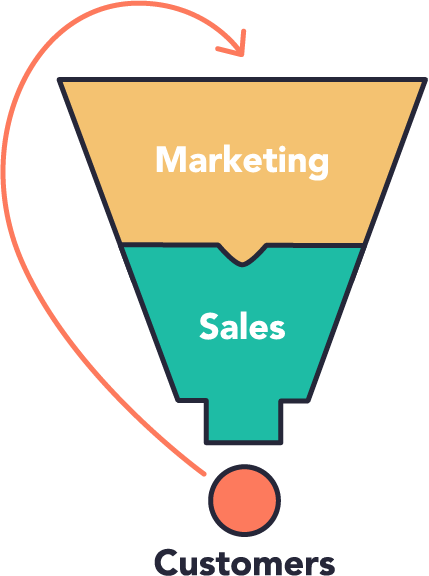
Whether you stick to the traditional funnel or adopt Hubspot’s flywheel thinking, you must take away one important and critical point from this post, customers are not just an output in your sales cycle they are an input.
How you retain, delight and capitalize on loyal customer sentiment is as important or MORE important than the number of prospects, MQLs, SQLs in other stages of your sales process.
- What customer focused marketing campaigns are you running this quarter?
- Which do you want to plan for next quarter?
- Where will you apply force to your flywheel?
- Where will you work to eliminate friction?
If you are unsure, find a growth marketer or inbounder to help you on your way.
Sources
https://blog.hubspot.com/marketing/our-flywheel
